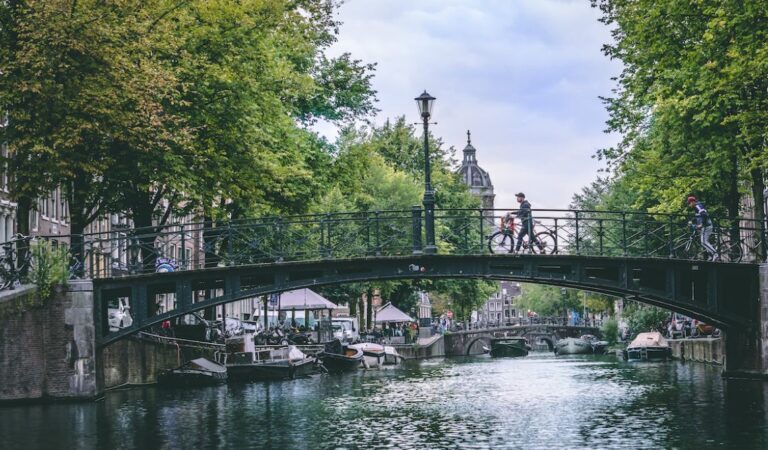Sustainable cities also known as green cities or eco-city, are cities that are designed, developed, and managed to meet the present needs of its residents without compromising the ability of future generations to meet their own needs.
It embodies a commitment to environmental, economic, and social sustainability to enhance the overall well-being of its inhabitants and the natural environment.
Table of Contents
The key traits of sustainable cities
1. Environmental sustainability
- Reduced environmental footprint
Sustainable cities strive to minimize resource consumption, waste generation, and pollution. They focus on energy efficiency, conservation of water, responsible waste management, and air quality improvements.
- Renewable energy use
Integration of renewable energy sources like solar, wind, and geothermal power to reduce reliance on fossil fuels and mitigate greenhouse gas emissions Biodiversity
- Biodiversity and green spaces
Preservation of natural habitats, creation of green spaces, urban forests, parks, and gardens to enhance biodiversity, improve air quality, and provide recreational opportunities.
2. Economic viability
- Sustainable economic growth
Encouraging sustainable economic development through investments in clean technologies, green industries, and fostering entrepreneurship that aligns with environmental and social goals.
- Job creation and inclusive prosperity
Prioritizing job creation, ensuring equitable economic opportunities, and addressing social disparities to enhance the overall prosperity and well-being of the community.
3. Social equity and inclusion
- Equitable access to resources
Ensuring that all residents have equal access to essential resources such as housing, education, healthcare, transportation, and recreation, regardless of socioeconomic status or background.
- Community engagement and participation
Involving the community in decision-making processes, urban planning, and policy formulation to ensure that diverse perspectives are considered and the needs of the population are met.
4. Urban planning and design
- Compact urban development
Promoting compact, mixed-use developments to minimize urban sprawl, reduce commuting distances, and encourage walking, cycling, and the use of public transportation.
- Efficient infrastructure
Designing infrastructure that is energy-efficient, resource-efficient, and capable of withstanding climate change impacts and natural disasters.
5. Smart technologies and innovation
- Integration of smart solutions
Utilizing innovative technologies and data-driven solutions for efficient energy and resource management, traffic optimization, waste reduction, and enhanced public services.
- Research and innovation hubs
Fostering innovation centers, research institutes, and partnerships that promote sustainable technologies and practices.
6. Resilience and climate adaptation
- Climate resilience
Implementing measures to adapt to and mitigate the impacts of climate change, including extreme weather events, sea-level rise, and other environmental challenges.
- Disaster preparedness
Planning and preparing for natural disasters by building resilient infrastructure and implementing effective emergency response strategies. A sustainable city aims to balance the needs of the environment, economy, and society, ultimately creating a livable, prosperous, and resilient urban environment for its present and future inhabitants.
Examples of sustainable cities
1. Copenhagen, Denmark
Copenhagen is a leader in sustainable urban planning and design. It prioritizes cycling and pedestrian infrastructure, which reduces traffic congestion and promotes a healthier lifestyle.
The city has ambitious goals to be carbon-neutral by 2025 and utilizes wind power for a significant portion of its energy needs. Green spaces, renewable energy, and a strong emphasis on public transportation contribute to its sustainability.
2. Amsterdam, Netherlands
Amsterdam is renowned for its cycling culture and comprehensive public transportation systems. The city encourages sustainable mobility options, and a significant portion of its population commutes by bike or public transport.
Urban planning supports compact, walkable neighborhoods, green spaces, and renewable energy initiatives, making it an environmentally conscious and sustainable city.
3. Curitiba, Brazil
Curitiba is recognized for its innovative urban planning and public transportation system. The city’s bus rapid transit (BRT) system is efficient, reducing congestion and promoting mass transit.
It also emphasizes green urban planning, waste recycling, and environmental preservation, making it a pioneer in sustainable development in Latin America.
4. Stockholm, Sweden
Stockholm is committed to reducing its carbon emissions and transitioning to renewable energy sources. The city incorporates efficient waste management, extensive green spaces, sustainable urban planning, and an emphasis on clean and efficient public transportation. Its efforts to be a fossil fuel-free city by 2040 showcase a strong commitment to sustainability.
5. Portland, Oregon, USA
Portland is known for its sustainable transportation options, including an extensive public transit system, dedicated bike lanes, and a pedestrian-friendly urban layout. The city promotes eco-friendly building practices, green roofs, local food initiatives, and a strong community focus on sustainability.
6. Singapore
Singapore addresses challenges such as limited space and water resources by employing innovative solutions. The city integrates smart technologies, energy-efficient buildings, water recycling, sustainable waste management, and an emphasis on greenery through its “City in a Garden” initiative. It also promotes public transportation and aims to achieve 80% of trips via public transport by 2030.
Considerations of sustainable cities
Sustainable cities are urban centers that prioritize environmentally responsible practices, economic viability, and social equity to enhance the well-being of current and future generations.
These cities are designed and developed with a holistic approach, considering the interconnections between the environment, economy, and society.
Sustainable cities embody a commitment to a better future, striving to balance economic growth with environmental stewardship and social equality. By implementing sustainable practices and engaging communities, these cities aim to create a more livable, prosperous, and harmonious urban environment.
It is through continued efforts and global collaboration that we can drive sustainable urban development and pave the way for a sustainable future.
Read also: Zone 30 in cities: slow down to save the planet and improve urban mobility












